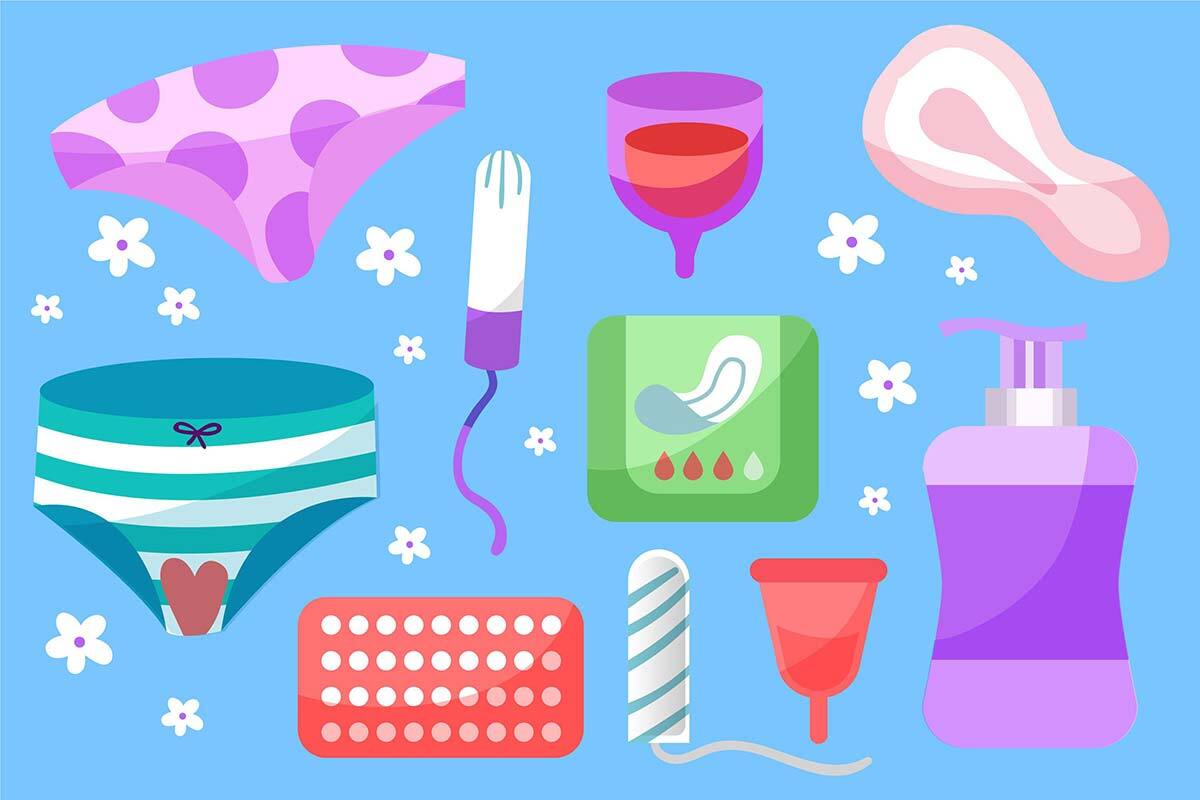Menstrual Hygiene Products

Know your options – Menstrual Hygiene Products!
Every menstruator has the right to choose the best menstrual hygiene product for themselves; taking into account factors such as availability, affordability, accessibility, method of use and environmental sustainability. Understanding the variety of menstrual hygiene products available is important to ensure a well-informed decision is made regarding menstrual health. Menstrual hygiene products available in Sri Lanka include menstrual pads (both disposable and reusable), tampons, menstrual cups, menstrual discs and menstrual underwear.
Menstrual Pads
Disposable menstrual pads are the commonest type of menstrual hygiene product available in Sri Lanka and can be easily found in both rural and urban areas. They are usually made of materials such as rayon, plastics and cotton. The underside of the pad has a sticky layer in order to adhere to underwear and prevent leaks. Some pads also have “wings” to further secure the pads to the underwear. Reusable pads are made of cotton and usually have wings with a clasp to help secure the pad to the underwear. Both disposable and reusable pads have regular sizes for regular menstrual flows, and larger sizes for heavier/night menstrual flows. Menstrual pads (both disposable and reusable) must be changed every 4 to 6 hours in order to maintain good menstrual hygiene. Wearing used pads for a longer duration can lead to skin irritation and reproductive tract infections.
Disposable pads must be discarded in a bin after use. It should not be flushed in the toilet as it can block pipes. Disposable pads are not environmentally friendly and take more than 600 years to decompose, which can lead to landfills. Reusable pads must be washed with luke warm water and soap after use. It should then be dried using sunlight as UV rays to kill any bacteria/fungi that can cause infections. Once completely dried, the pad must be stored in a pouch in a cool, dry area until use for the next period.
Disposable pads range in price depending on the type of pad and number in a pack. Reusable pads have a higher initial cost, but can be used generally for about 36 washes.
Tampons
Menstrual tampons are small devices made of rayon with or without cotton and are inserted internally into the vaginal cavity to absorb the menstrual blood. Some tampons may have a plastic or paper applicator to help insertion. The tampons expand in the vaginal cavity to absorb the blood. Tampons have a string attached at the end, which comes out through the vaginal cavity, aiding removal of the tampon after 4 to 6 hours. Tampons are available for light, regular and heavy menstrual flows, but must be changed every 4 to 6 hours to prevent serious reproductive tract infections such as Toxic Shock Syndrome, that can occur if the tampon is left for longer hours. Whilst initial insertion can be tricky, the squatting position or by placing one leg on the commode can help widen the pelvis and make insertion easier. As tampons are internally placed, they do not cause much discomfort to the user, and the menstruator can swim or take part in other activities whilst wearing it. Tampons should be discarded in bins as they are not biodegradable.
Menstrual cups
Menstrual cups are made from medical grade silicon or rubber, and are flexible devices that can be folded and inserted into the vaginal cavity to collect menstrual blood. They come in different sizes. The user should boil the cup prior to insertion for a few minutes in order to sterilize it and then dry before placing it in a covering. It can then be inserted using different positions such as by squatting or by placing one leg on the commode to widen the pelvis. The menstrual cup is folded to decrease the diameter and make insertion easier. The menstrual cup can be worn for between 8 to 12 hours. After the time period, the cup can be removed by gently pulling down on the tail of the cup, and the menstrual blood should be emptied in the commode. The cup can then be directly reinserted or rinsed before reinsertion. After the menstrual period is over, the cup should then be rinsed, boiled for a few minutes, dried and stored until the next period. The menstrual cup can be reused for up to 5-10 years and therefore is an eco-friendly option.
Menstrual disc
The menstrual disc is a newer type of menstrual hygiene product that is similar to the menstrual cup, but is inserted deeper into the vaginal canal, just below the cervix. Both disposable and reusable options are available. It can be worn for up to 12 hours, but if the menstruator has a heavier flow, the cup will need to be changed more often. Users can also engage in sexual intercourse whilst wearing the menstrual disc.
Menstrual underwear
Menstrual underwear is similar to normal underwear, but has a thickened lining in order to absorb menstrual blood. It can be worn alone or with another menstrual product for added protection to prevent leaks. It should be hand washed to remove clots after use and then dried completely in sunlight to prevent growth of harmful organisms that can lead to infection. They must be changed every 4 to 6 hours.
Always remember that hand washing is extremely important both before and after changing menstrual hygiene products in order to prevent reproductive tract infections, and the product should not be worn for longer than the recommended use time as this can increase the risk of reproductive tract infections.
Whatever method is chosen, it is important to consider the pros and cons of each method to find the best fit for you.
.png)



